1. Arias-Santiago S, Buendía-Eisman A, Aneiros-Fernández J, et al. Lipid levels in patients with lichen planus: a case-control study. J Eur Acad Dermatol Venereol. 2011; 25:1398–1401.
2. Arias-Santiago S, Buendía-Eisman A, Aneiros-Fernández J, et al. Cardiovascular risk factors in patients with lichen planus. Am J Med. 2011; 124:543–548.
3. Bacaksiz A, Erdogan E, Tasal A, et al. Electrocardiographic P-wave characteristics in patients with psoriasis vulgaris. Ups J Med Sci. 2013; 118:35–41.
4. Ahlehoff O, Gislason GH, Jørgensen CH, et al. Psoriasis and risk of atrial fibrillation and ischaemic stroke: a Danish Nationwide Cohort Study. Eur Heart J. 2012; 33:2054–2064.
5. Acar G, Sayarlioğlu M, Akçay A, et al. Evaluation of atrial electromechanical delay and left atrial mechanical functions in patients with rheumatoid arthritis. Turk Kardiyol Dern Ars. 2009; 37:447–453.
6. Deniz A, Yavuz B, Aytemir K, et al. Intra-left atrial mechanical delay detected by tissue Doppler echocardiography can be a useful marker for paroxysmal atrial fibrillation. Echocardiography. 2009; 26:779–784.
7. Deniz A, Sahin DY, Kanadasi M, et al. Conduction characteristics in atrial fibrillation. Predictive value of tissue Doppler echocardiography. Herz. 2014; 39:137–141.
8. Sahin M, Bilgili SG, Simsek H, et al. Increased P-wave dispersion in patients with newly diagnosed lichen planus. Clinics (Sao Paulo). 2013; 68:846–850.
9. Ari H, Ari S, Akkaya M, et al. Predictive value of atrial electromechanical delay for atrial fibrillation recurrence. Cardiol J. 2013; 20:639–647.
10. Simsek H, Gunes Y, Demir C, Sahin M, Gumrukcuoglu HA, Tuncer M. The effects of iron deficiency anemia on p wave duration and dispersion. Clinics (Sao Paulo). 2010; 65:1067–1071.
11. Lang RM, Bierig M, Devereux RB, et al. Recommendations for chamber quantification: a report from the American Society of Echocardiography's Guidelines and Standards Committee and the Chamber Quantification Writing Group, developed in conjunction with the European Association of Echocardiography, a branch of the European Society of Cardiology. J Am Soc Echocardiogr. 2005; 18:1440–1463.
12. Rudski LG, Lai WW, Afilalo J, et al. Guidelines for the echocardiographic assessment of the right heart in adults: a report from the American Society of Echocardiography endorsed by the European Association of Echocardiography, a registered branch of the European Society of Cardiology, and the Canadian Society of Echocardiography. J Am Soc Echocardiogr. 2010; 23:685–713.
13. Sahin M, Simsek H, Akyol A, et al. A new echocardiographic parameter of arterial stiffness in end-stage renal disease. Herz. 2014; 39:749–754.
14. Ozer N, Yavuz B, Can I, et al. Doppler tissue evaluation of intra-atrial and interatrial electromechanical delay and comparison with P-wave dispersion in patients with mitral stenosis. J Am Soc Echocardiogr. 2005; 18:945–948.
15. Middel P, Lippert U, Hummel KM, et al. Expression of lymphotoxinalpha by keratinocytes: a further mediator for the lichenoid reaction. Pathobiology. 2000; 68:291–300.
16. Flammer AJ, Ruschitzka F. Psoriasis and atherosclerosis: two plaques, one syndrome? Eur Heart J. 2012; 33:1989–1991.
17. Michelucci A, Bagliani G, Colella A, et al. P wave assessment: state of the art update. Card Electrophysiol Rev. 2002; 6:215–220.
18. Calık AN, Ozcan KS, Cağdaş M, et al. Electromechanical delay detected by tissue Doppler echocardiography is associated with the frequency of attacks in patients with lone atrial fibrillation. Cardiol J. 2014; 21:138–143.
19. Nar G, İnci S, Aksan G, Soylu K, Demirelli S, Nar R. The relationships between atrial electromechanical delay and CHA2DS2-VASc score in patients diagnosed with paroxysmal AF. Echocardiography. 2015; 32:1359–1366.







 PDF
PDF ePub
ePub Citation
Citation Print
Print



 XML Download
XML Download